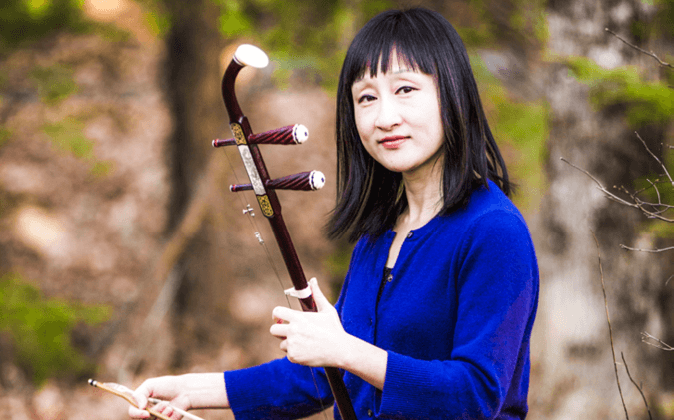NEW YORK— Inside the 23rd Street F station, a petite Japanese girl stood exceptionally still in front of what looked like a wooden radio receiver. By flickering her hands—and only her hands—through small movements in the air, she produced a stirring performance of Schubert’s “Ave Maria.”
Llamano (the girl’s stage name, which she prefers to appear in the press) was playing the theremin, an early electronic musical instrument. Its volume and pitch are controlled by the distance between the player’s hands and two metal rods.
Most listeners will recognize the theremin as the special sound effect in the Beach Boys’ song “Good Vibrations,” or in music from Twilight Zone episodes.
Yet, with an instrument that is often used for its eerie sound, Llamano finds that it also has a capacity to convey the most beautiful of feelings.
A contemporary instrument and classical musical are not necessarily mutually exclusive.
“Classical songs can be played on contemporary instruments as long as the sound is beautiful,” she said. “The feeling is what’s most important.”
Llamano said that many modern songs are ephemeral, while classical music continues to move hearts centuries later.
“Classical songs are very deep. Their songs stay alive because [the composers] could put their spirit in their songs,” Llamano said. “But nowadays, some songs are very good, but some are just trendy. They die with the physical body because the artists did not put their soul into the music.”
“Classical music has such a huge feeling. For example, Rachmaninoff, when I hear his music, I can feel Russia, and I can see its scenery even though I’ve never been there,” she said. “I feel that is because he has put his spirit in his music.”
Llamano doesn’t only play classical music, she also plays contemporary songs and her own compositions.
She loves composing, but for some reason she never felt completely comfortable with the piano and guitar, the instruments she studied.
Llamano was 19 when she first came across the theremin. She had been living in Yokohama City when her sister showed her a newspaper clipping about an instrument that one did not need to touch to play.
“I decided that I wanted to learn it, even before I saw it or heard it. It was a strange feeling, it was almost like a sixth sense told me that this was the instrument for me,” she said.
After going to a theremin concert, she felt that she had found the instrument with which she could best express herself musically. She has been playing for about 10 years.
“It has limitations, but it also has unlimited potential,” Llamano said.
Like a human voice, the theremin is unable to create harmony by itself. It is a unique instrument that is incredibly sensitive to the environment and even the mood and physical well-being of the player.
The instrument is susceptible to very small movements. Drinking coffee can make the vibrato get out of hand. The player needs to stand completely still and move only the hands and arms in order to have the most control over the sound.
It is also incredibly difficult to play this instrument in tune. Theremins players must have an exceptional ear. When their hands are moving in the air, they can only rely on their ear to judge the pitch and distance. Yet Llamano played with wonderful intonation.
“Although there are physical limitations with the theremin, there is actually more freedom,” she said.
“It’s like when someone is in jail. Your physical environment limits you, but it doesn’t limit your heart,” she said. “I think this applies to life too. Music can bring you freedom, regardless of the limitations of your environment.”
Despite the limitations of her instrument, Llamano played “Ave Maria” with riveting feeling. There was something very pure in her sound even though it came from a complicated instrument.
But it wasn’t easy getting to where she is today.
Ten years ago, there had only been two theremin teachers in the entire country of Japan. Luckily, one of the two teachers happened to live in Tokyo, which was a close commute from Yokohama.
The theremin lessons cost $60 for half an hour. “For years, I barely spent money on anything except the lessons,” she said. But she kept going anyway because she felt that it was only through the theremin that she could compose and play with her whole soul.
Llamano learned fast. Within four years she was invited to perform with her teacher in a concert.
How the Theremin Works
The theremin was invented by Russian physicist Leon Theremin, who patented the instrument in the United States in 1928.
He had been sponsored by the Russian government to create Russian spy technology, researching sensors that would detect the presence of nearby objects or people without making physical contact.
The instrument consists of a rectangular box with a vertical antenna on the right side, and a horizontal metal loop that comes out from its left side.
The volume is controlled by the left hand. The further the hand is away from the metal loop, the louder the sound becomes. The right hand controls the pitch. The note becomes higher as the right hand moves closer to the antenna.
The electric signals from the theremin are amplified and sent to a speaker.
Where to Find Llamano
Llamano carries the heavy speaker and instrument to the Manhattan subways to play everyday. She plays inside the 14th St. F station, 57th St. F station, and on some days the 23rd St. Downtown F station from 4 to 9 p.m.
She has met many people through subway performances and even found a gig at Joe’s Pub.
“Playing in the subway is hard, ... but I want people to enjoy listening to this new sound,” she said.
Llamano is in New York City until the end of July when she will return to Japan. She will return to the states to perform at Bucknell University in Pa. on Oct. 30.
Some parts of the interview were conducted through a translator, Rie Funatsu.





